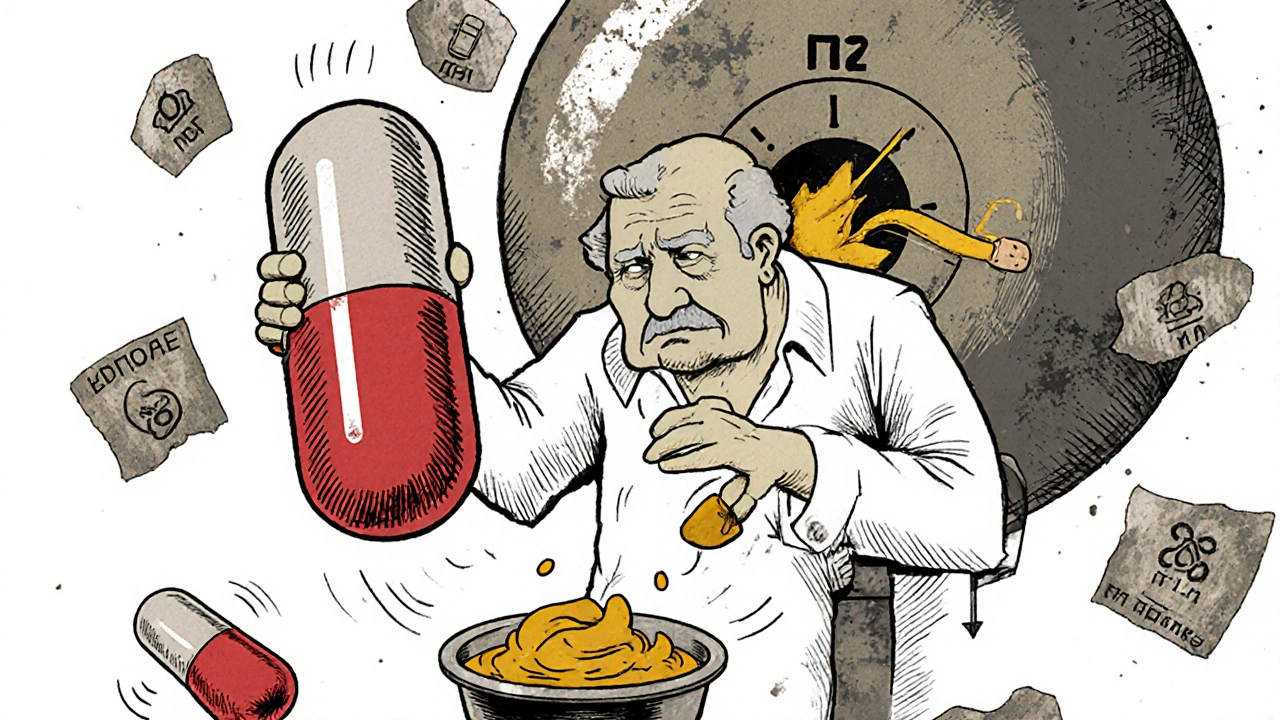Medication Formulation Side Effect Calculator
When you pick up a prescription, you might not think twice about whether it’s a tablet, capsule, or extended-release pill. But the form you’re taking can change how your body handles the drug - and that affects everything from how fast you feel relief to how many side effects you get. It’s not just about what’s in the pill. It’s about how it’s built.
Tablets vs Capsules: What’s Really Different?
Tablets and capsules might look similar, but they work differently from the moment they hit your stomach. Tablets are compressed powders held together with binders. They usually take 30 to 60 minutes to break down in gastric fluid. Capsules, on the other hand, are shells - often made of gelatin or plant-based materials - that enclose powder or liquid. Because they dissolve faster, capsules typically get into your bloodstream 20-30% quicker than tablets. That’s why some medications, like pain relievers or antibiotics, come as capsules: you need the drug to act fast. But speed isn’t everything. Tablets last longer on the shelf. At room temperature, they can stay stable for 2-3 years longer than capsules. That’s why pharmacies stock more tablets for long-term conditions. Capsules are more sensitive to heat and moisture. If you leave them in a hot bathroom, they can soften or stick together. Tablets? They’ll just sit there, unchanged.Extended-Release: The Slow Burn Approach
Extended-release (ER), sustained-release (SR), or extended-duration (XR/XL) formulations are designed to let the drug leak out slowly over 12 to 24 hours. That means you take one pill instead of three. For people managing chronic conditions like high blood pressure, epilepsy, or depression, that’s a game-changer. These aren’t just bigger pills with more drug. They’re engineered with special coatings or matrices. Some use hydrophilic polymers like HPMC that swell in water and control how fast the drug escapes. Others use hydrophobic materials like ethylcellulose that act like a barrier. There are even osmotic systems - tiny pills with a laser-drilled hole that push the drug out using pressure from water entering the tablet. The result? Instead of a spike in drug levels right after taking it, your blood concentration stays steady. That’s key. When drug levels jump too high, you get side effects. When they dip too low, the medicine stops working. ER formulations cut those swings by 40-60% compared to immediate-release versions.How Side Effects Change with Formulation
Side effects aren’t random. They’re often tied to how high the drug spikes in your blood. Take bupropion, an antidepressant. The immediate-release version causes nausea in nearly 19% of users. The extended-release version? Just 13%. Why? Because the drug doesn’t flood your system all at once. Same with venlafaxine. The immediate-release form causes dizziness in 28% of people. The XR version? Only 22%. Nausea drops from 20% to 16%. These aren’t small differences. For someone already struggling with anxiety or depression, fewer side effects mean they’re more likely to stick with the treatment. A 2017 review of 15 studies found that extended-release versions of antiepileptic drugs like carbamazepine and levetiracetam had 25-40% fewer concentration-dependent side effects than immediate-release versions. That includes dizziness, drowsiness, and nausea - the very things that make people quit their meds. But here’s the catch: ER doesn’t eliminate side effects. It just shifts them. Some people report constipation or bloating with extended-release pills because the drug is lingering in the gut longer. Others say they feel worse if they miss a dose - not because the drug stopped working, but because their body got used to the steady drip.
When Extended-Release Goes Wrong
Extended-release pills are great - until they’re not. If you crush one, split it, or chew it, you can trigger something called “dose dumping.” That’s when the entire dose floods into your system at once. For medications like opioids or stimulants, that can be deadly. Even without tampering, some people’s bodies don’t process ER pills the same way. If you have gastroparesis - a condition where the stomach empties slowly - the pill might sit there too long, then release all at once. Or if your gut moves too fast, the drug might not release properly. Studies show 5-10% of people with gut motility issues get inconsistent absorption from ER formulations. Food can also mess with them. A high-fat meal can change how fast the drug releases by 20-35% in 15% of approved ER products. That’s why some labels say “take on an empty stomach.” If you’re not told this, you might think the medicine isn’t working - when it’s just your breakfast interfering.Who Benefits Most - and Who Should Avoid ER
The American College of Clinical Pharmacy recommends extended-release formulations for chronic conditions where daily dosing is a burden. Think bipolar disorder, ADHD, hypertension, or chronic pain. One case study showed a patient with bipolar disorder went from 65% adherence on three-times-daily pills to 92% on once-daily ER quetiapine. Their mood episodes dropped by 47% in a year. But ER isn’t for everyone. If you have trouble swallowing pills, ER versions can be a nightmare. They’re often larger and harder than immediate-release tablets. A 2022 Mayo Clinic survey found 27% of elderly patients struggled with them. If you’re on a feeding tube or need crushed meds, ER is out. People who’ve had recent GI surgery, severe IBS, or Crohn’s disease should also be cautious. The same systems that help most people can cause unpredictable absorption in these groups. Doctors need to know your full history before prescribing ER.The Cost and Convenience Trade-Off
Extended-release versions cost more. A lot more. On average, they’re 2.3 times the price of immediate-release equivalents. A month’s supply of generic bupropion immediate-release might be $15. The extended-release version? $185. That’s why some patients switch back - even if they feel better on ER. But the cost isn’t just in dollars. It’s in time, too. Developing an ER formulation takes 36-48 months - twice as long as a regular tablet. That’s why only 35% of new drugs approved between 2015 and 2022 included extended-release versions. The technology is complex, and not every drug can be made to work this way.
What the Labels Really Mean
Not all “extended-release” labels are the same. DR means delayed-release - like enteric-coated pills that don’t dissolve until they hit the intestine. SR means sustained-release - slow and steady. ER, XR, XL all mean extended-release, but they’re not always identical. One company’s XL might release over 12 hours. Another’s might go 24. Always check the prescribing information. You’ll also see suffixes like “CR” (controlled-release) or “CD” (controlled-delivery). These aren’t marketing fluff. They’re technical terms. If you’re switching brands, ask your pharmacist: “Is this the same release type?”What to Do If You’re Struggling
If you’re having side effects, ask: “Could this be because of how the pill releases?” Don’t assume it’s just your body reacting. Talk to your doctor about switching formulations. Sometimes, going from a tablet to a capsule - or from immediate-release to extended-release - makes all the difference. If you can’t swallow the pill, don’t crush it. Ask if there’s a liquid version, or a smaller tablet. Some ER medications now come in sprinkle capsules you can open and mix with applesauce - but only if the label says it’s safe. And if you miss a dose? With some ER drugs, you can take it anytime within 24 hours. With others, you have to wait until the next day. Check the instructions. Don’t guess.The Future of Pill Design
Newer ER systems are getting smarter. Rytary, for example, releases carbidopa-levodopa in three pulses throughout the day - reducing “off” time in Parkinson’s patients by over two hours. Other systems are being tested to stay in the stomach for a full day, or to release only in certain parts of the intestine. But challenges remain. Polymer coatings from these pills are showing up in wastewater - a growing environmental concern. And regulators are cracking down on companies that don’t prove their ER products work the same in every patient. By 2030, nearly half of all oral pills will be extended-release. The demand is there: aging populations want fewer pills. But the key isn’t just more ER drugs. It’s smarter use of them - matching the right formulation to the right person.Can I crush an extended-release tablet if I can’t swallow it?
No. Crushing an extended-release tablet can cause the entire dose to be released at once, which can lead to dangerous side effects or overdose. Always check the medication label or ask your pharmacist before altering the pill. Some extended-release medications come in sprinkle capsules or liquid forms - ask if one of those options is available.
Why do extended-release pills cost more?
Extended-release formulations require complex manufacturing processes, specialized polymers, and years of testing to ensure consistent drug release. Development costs are about 2.5 times higher than for immediate-release versions. These costs are passed on to consumers, which is why ER versions often cost 2-3 times more than their immediate-release counterparts.
Do extended-release medications have fewer side effects?
Yes, for many medications. Because they release the drug slowly, they avoid the sharp spikes in blood concentration that cause side effects like nausea, dizziness, and jitteriness. For example, extended-release bupropion reduces nausea by 30% compared to the immediate-release version. However, they can cause other issues like constipation or bloating due to prolonged gut exposure.
Can food affect how extended-release pills work?
Yes. High-fat meals can alter how quickly or completely the drug is released in 15% of FDA-approved extended-release products. Some medications must be taken on an empty stomach, while others work better with food. Always follow the instructions on your prescription label - and tell your doctor if you notice changes in how you feel after eating.
What’s the difference between SR, ER, XR, and XL?
SR (sustained-release), ER (extended-release), XR (extended-release), and XL (extended-release, extended duration) all mean the drug is released slowly. But they’re not always the same. Different manufacturers use different technologies, so one company’s XL might last 24 hours while another’s ER lasts 12. Always check the prescribing information for exact release profiles - don’t assume they’re interchangeable.
Are extended-release pills better for older adults?
They can be - if swallowing isn’t a problem. Fewer daily doses improve adherence, which reduces hospitalizations and improves outcomes. But many ER pills are larger and harder to swallow. A 2022 Mayo Clinic survey found 27% of elderly patients struggled with them. For older adults, consider asking about liquid forms, sprinkle capsules, or smaller tablets if swallowing is difficult.
What should I do if I miss a dose of an extended-release medication?
It depends on the drug. For some, like Trokendi XR (topiramate ER), you can take the missed dose anytime within the next 24 hours. For others, you should skip it and wait until the next scheduled dose. Never double up. Always check the patient information leaflet or ask your pharmacist - taking too much too soon can be dangerous.
Why can’t I switch between brand-name and generic extended-release pills?
Even if two pills have the same active ingredient, their release mechanisms may differ. The FDA requires generic ER drugs to match the brand in release rate, but not all generics do. Some patients report different side effects or effectiveness after switching. If you notice changes, tell your doctor. You may need to stick with one brand or version.


Ragini Sharma
November 22, 2025 AT 01:38Linda Rosie
November 22, 2025 AT 04:59Vivian C Martinez
November 24, 2025 AT 01:08Ross Ruprecht
November 25, 2025 AT 01:24Bryson Carroll
November 25, 2025 AT 01:41Lisa Lee
November 26, 2025 AT 15:48Jennifer Shannon
November 27, 2025 AT 11:43Suzan Wanjiru
November 28, 2025 AT 10:58Kezia Katherine Lewis
November 29, 2025 AT 14:53Henrik Stacke
November 30, 2025 AT 11:37Manjistha Roy
December 1, 2025 AT 12:34Jennifer Skolney
December 2, 2025 AT 09:19JD Mette
December 3, 2025 AT 04:08Ragini Sharma
December 3, 2025 AT 07:17